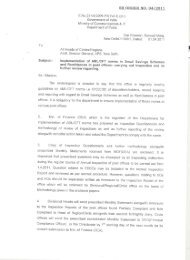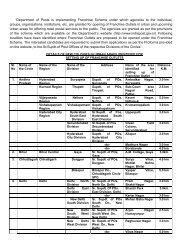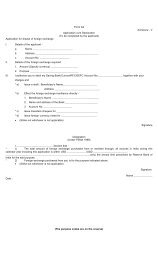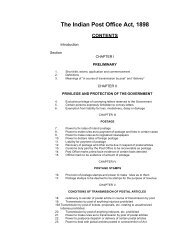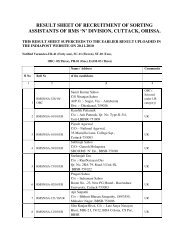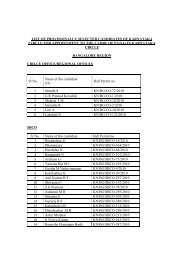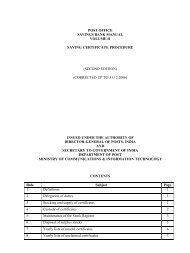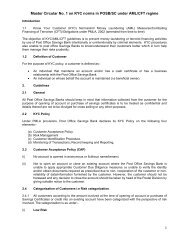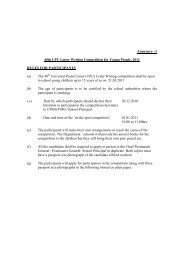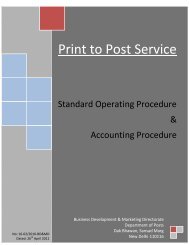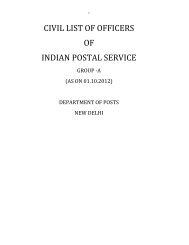Postal Manual Vol. VIII - India Post
Postal Manual Vol. VIII - India Post
Postal Manual Vol. VIII - India Post
Create successful ePaper yourself
Turn your PDF publications into a flip-book with our unique Google optimized e-Paper software.
(2) The monthly receipts and disbursements will be obtained in the following manner :-<br />
(a) In the case of head office – Take the head office summary, and add together (i) the<br />
totals of receipts, and (ii) the totals of payments, for the month, after excluding from<br />
those totals drawings from, and remittances to, the treasury and such transfers of cash<br />
from or to other head offices as have been made for the purpose of replenishing the<br />
funds of the head office in question or of disposing of its surplus collections.<br />
(b) In the case of sub-office. – Take the copy of the sub-office account, and add together (i)<br />
the monthly totals of all the columns under the head of receipts, and (ii) the monthly<br />
totals of the columns under the head of payments, with the exception of the totals of the<br />
columns showinig the postage due on articles of the letter mail received for delivery<br />
and returned undelivered, the drawings from, and remittances to, the treasury, ad<br />
remittances from and to the head office or other sub-offices.<br />
NOTE – If however, the sub-office is a cash office, remittances from or to other sub-offices must be<br />
taken into account.<br />
From the figures showing the monthly receipts and disbursements thus arrived at, deduct the total<br />
amounts, shown under the heads of “receipts” and “payments’ respectively, in the abstracts of the<br />
transactions of branch offices for the same month, after excluding from those amounts the postage<br />
due on articles of the letter mail received for delivery and returned undelivered, the direct drawings<br />
from and remittances to, the treasuty (if any), and remittances from and to the account office. To<br />
the balance of receipts and the total amount shown in the abstracts as remitted to the account<br />
office, and to the balance of disbursements add the total amount shown in the abstracts as received<br />
from the account office.<br />
(c) In the case of a branch office. – Take the B.O. account for the month and note down the<br />
amounts shown under the heads of ‘receipts’ and ‘payments’, after excluding from<br />
those amounts the postage due on articles of the letter mail received for delivery and<br />
returned undelivered, the direct drawings from, and remittances to, the treasury (if any),<br />
and remittances from and to the account office.<br />
NOTE.- It is intended, that the calculation of the average receipts and disbursements, for the purpose<br />
of this rule should be based on the actual cash transactions of the office and, therefore, items such as<br />
payments on account of Land and Miscellaneous Revenue money orders, which are adjusted by book debit,<br />
should be excluded from the calculation.<br />
(3) With the data mentioned in paragraph (1) of this rule, the principles stated in the two<br />
preceeding rules can, in ordinary cases, be applied without difficulty in fixing the minimum and<br />
maximum cash balances of any office. In special cases, however where a suitable maximum cash<br />
balance cannot be fixed on those data, the <strong>Post</strong>master-General may fix the maximum cash balance<br />
on such data and in such a way, as the circumstances of the case demand. For instance, in the case<br />
of an office the receipts of which are largely in excess of the payments, which makes its daily<br />
remittance to the treasury, head office, or cash office at noon, and where heavy postal collections<br />
are made after that hour, while the payments are made chiefly in the morning , the average net<br />
receipts between the hour at which the remittance for the day is made and the close of the day<br />
would probably make a suitable maximum cash balance.<br />
(4) The following are a few examples or ordinary cases :-<br />
I. Cases in which the receipts are greater than the payments





